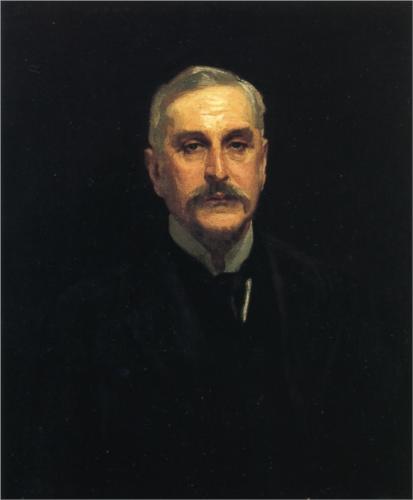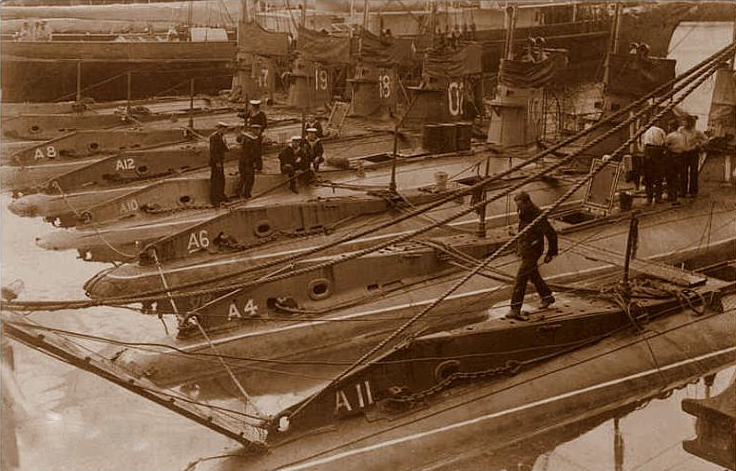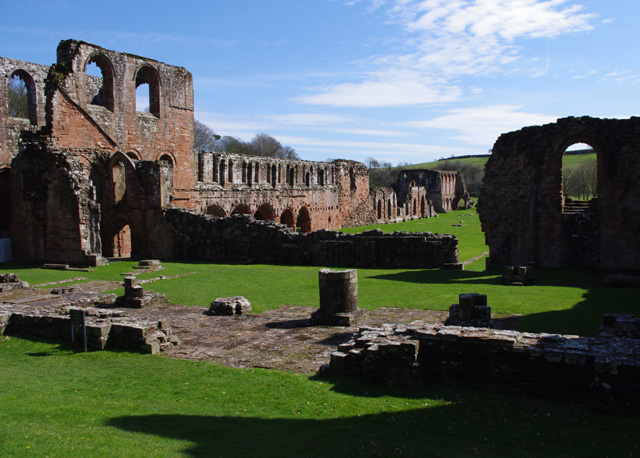|
HMS B9
HMS ''B9'' was one of 11 B-class submarines built for the Royal Navy in the first decade of the 20th century. Completed in 1906, she was initially assigned to the Home Fleet, before the boat was transferred to the Mediterranean six years later. After the First World War began in 1914, ''B9'' played a minor role in the Dardanelles Campaign. The boat was transferred to the Adriatic Sea in 1916 to support Italian forces against the Austro-Hungarian Navy. She was converted into a patrol boat in 1917 and was sold for scrap in 1919. Design and description The B class was an enlarged and improved version of the preceding A class. The submarines had a length of overall, a beam of and a mean draft of . They displaced on the surface and submerged. The boats could dive to a depth of . The B-class submarines had a crew of two officers and thirteen ratings.Gardiner & Gray, p. 87 For surface running, the boats were powered by a single 16-cylinder Vickers petrol engine tha ... [...More Info...] [...Related Items...] OR: [Wikipedia] [Google] [Baidu] |
Vickers Limited
Vickers Limited was a British engineering conglomerate. The business began in Sheffield in 1828 as a steel foundry and became known for its church bells, going on to make shafts and propellers for ships, armour plate and then artillery. Entire large ships, cars, tanks and torpedoes followed. Airships and aircraft were added, and Vickers jet airliners were to remain in production until 1965. Financial problems following the death of the Vickers brothers were resolved in 1927 by separating Metropolitan Carriage Wagon and Finance Company and Metropolitan-Vickers, then merging the remaining bulk of the original business with Armstrong Whitworth to form Vickers-Armstrongs. The Vickers name resurfaced as Vickers plc between 1977 and 1999. History Foundry Vickers was formed in Sheffield as a steel foundry by the miller Edward Vickers and his father-in-law George Naylor in 1828. Naylor was a partner in the foundry Naylor & Sanderson, and Vickers' brother William owned a steel roll ... [...More Info...] [...Related Items...] OR: [Wikipedia] [Google] [Baidu] |
A-class Submarine (1903)
The A class was the Royal Navy's first class of British-designed submarines. Thirteen were built by Vickers at Barrow-in-Furness between 1902 and 1905 as an improvement on the US . Design and construction While there was considerable variation amongst the boats of the class, they were around long and displaced around 200 tons when submerged. The first, ''A1'' (ordered as ''Holland No. 6''), was launched in July 1902, the last, ''A13'', in April 1905. Propulsion All were propelled underwater by battery-powered electric motors and on the surface by shaft-drive Wolseley petrol engines of (''A1''), (''A2-A4'') or (''A5''-''A12''). ''A13'' had an experimental Vickers diesel engine, which proved to be unreliable. Armaments Armament was two torpedo tubes with four torpedoes except for ''A1'', which had 1 tube and 3 torpedoes. Service history This submarine class was plagued by numerous accidents and failures; almost every boat in the class (''A1'', ''A3'', ''A4'', ... [...More Info...] [...Related Items...] OR: [Wikipedia] [Google] [Baidu] |
Crown Colony Of Malta
The Crown Colony of the Island of Malta and its Dependencies (commonly known as the Crown Colony of Malta or simply Malta) was the British colony in the Maltese islands, today the modern Republic of Malta. It was established when the Malta Protectorate was transformed into a British Crown colony in 1813, and this was confirmed by the Treaty of Paris in 1814. Establishment and early years (1813–1824) From 1530 to 1798, Malta had been ruled by the Order of Saint John. The Order was ousted during the War of the Second Coalition and Malta was occupied by Napoleon. The Maltese rebelled after a couple of months of French rule and asked Britain for help. Eventually, the French capitulated in 1800 and Malta voluntarily became a British protectorate. Britain was then supposed to evacuate the island according to the terms of the Treaty of Amiens of 1802, but failed to keep this obligation – one of several mutual cases of non-adherence to the treaty, which eventually led to its c ... [...More Info...] [...Related Items...] OR: [Wikipedia] [Google] [Baidu] |
Straits Of Dover
The Strait of Dover or Dover Strait (french: Pas de Calais - ''Strait of Calais''), is the strait at the narrowest part of the English Channel, marking the boundary between the Channel and the North Sea, separating Great Britain from continental Europe. The shortest distance across the strait, at approximately 20 miles (32 kilometres), is from the South Foreland, northeast of Dover in the English county of Kent, to Cap Gris Nez, a cape near to Calais in the French département of Pas-de-Calais. Between these points lies the most popular route for cross-channel swimmers. The entire strait is within the territorial waters of France and the United Kingdom, but a right of transit passage under the United Nations Convention on the Law of the Sea allows vessels of other nations to move freely through the strait. On a clear day, it is possible to see the opposite coastline of England from France and vice versa with the naked eye, with the most famous and obvious sight being the White ... [...More Info...] [...Related Items...] OR: [Wikipedia] [Google] [Baidu] |
HMNB Devonport
His Majesty's Naval Base, Devonport (HMNB Devonport) is one of three operating bases in the United Kingdom for the Royal Navy (the others being HMNB Clyde and HMNB Portsmouth) and is the sole nuclear repair and refuelling facility for the Royal Navy. The largest naval base in Western Europe, HMNB Devonport is located in Devonport, in the west of the city of Plymouth, England. The base began as Royal Navy Dockyard in the late 17th century, but shipbuilding ceased at Devonport in the early 1970s, although ship maintenance work has continued. The now privatised maintenance facilities are operated by Babcock International Group, who took over the previous owner Devonport Management Limited (DML) in 2007. DML had been running the Dockyard since privatisation in 1987. From 1934 until the early 21st century the naval barracks on the site was named HMS ''Drake'' (it had previously been known as HMS ''Vivid'' after the base ship of the same name). The name HMS ''Drake'' and its c ... [...More Info...] [...Related Items...] OR: [Wikipedia] [Google] [Baidu] |
HMNB Portsmouth
His Majesty's Naval Base, Portsmouth (HMNB Portsmouth) is one of three operating bases in the United Kingdom for the Royal Navy (the others being HMNB Clyde and HMNB Devonport). Portsmouth Naval Base is part of the city of Portsmouth; it is located on the eastern shore of Portsmouth Harbour, north of the Solent and the Isle of Wight. Until the early 1970s, it was officially known as Portsmouth Royal Dockyard (or HM Dockyard, Portsmouth); thereafter the term 'Naval Base' gained currency, acknowledging a greater focus on personnel and support elements alongside the traditional emphasis on building, repairing and maintaining ships. In 1984 Portsmouth's Royal Dockyard function was downgraded and it was formally renamed the 'Fleet Maintenance and Repair Organisation' (FMRO). The FMRO was privatized in 1998, and for a time (from 2002 to 2014), shipbuilding, in the form of Shipbuilding#Modern shipbuilding manufacturing techniques, block construction, returned. Around 2000, the designat ... [...More Info...] [...Related Items...] OR: [Wikipedia] [Google] [Baidu] |
Ceremonial Ship Launching
Ceremonial ship launching involves the performance of ceremonies associated with the process of transferring a vessel to the water. It is a nautical tradition in many cultures, dating back thousands of years, to accompany the physical process with ceremonies which have been observed as public celebration and a solemn blessing, usually but not always, in association with the launch itself. Ship launching imposes stresses on the ship not met during normal operation and, in addition to the size and weight of the vessel, represents a considerable engineering challenge as well as a public spectacle. The process also involves many traditions intended to invite good luck, such as christening by breaking a sacrificial bottle of champagne over the bow as the ship is named aloud and launched. Methods There are three principal methods of conveying a new ship from building site to water, only two of which are called "launching". The oldest, most familiar, and most widely used is th ... [...More Info...] [...Related Items...] OR: [Wikipedia] [Google] [Baidu] |
Shipyard
A shipyard, also called a dockyard or boatyard, is a place where ships are built and repaired. These can be yachts, military vessels, cruise liners or other cargo or passenger ships. Dockyards are sometimes more associated with maintenance and basing activities than shipyards, which are sometimes associated more with initial construction. The terms are routinely used interchangeably, in part because the evolution of dockyards and shipyards has often caused them to change or merge roles. Countries with large shipbuilding industries include Australia, Brazil, China, Croatia, Denmark, Finland, France, Germany, India, Ireland, Italy, Japan, the Netherlands, Norway, the Philippines, Poland, Romania, Russia, Singapore, South Korea, Sweden, Taiwan, Turkey, the United Arab Emirates, Ukraine, the United Kingdom, the United States and Vietnam. The shipbuilding industry is more fragmented in Europe than in Asia where countries tend to have fewer, larger companies. Many naval vessels ar ... [...More Info...] [...Related Items...] OR: [Wikipedia] [Google] [Baidu] |
Barrow-in-Furness
Barrow-in-Furness is a port town in Cumbria, England. Historically in Lancashire, it was incorporated as a municipal borough in 1867 and merged with Dalton-in-Furness Urban District in 1974 to form the Borough of Barrow-in-Furness. In 2023 the borough will merge with Eden and South Lakeland districts to form a new unitary authority; Westmorland and Furness. At the tip of the Furness peninsula, close to the Lake District, it is bordered by Morecambe Bay, the Duddon Estuary and the Irish Sea. In 2011, Barrow's population was 56,745, making it the second largest urban area in Cumbria after Carlisle. Natives of Barrow, as well as the local dialect, are known as Barrovian. In the Middle Ages, Barrow was a small hamlet within the parish of Dalton-in-Furness with Furness Abbey, now on the outskirts of the town, controlling the local economy before its dissolution in 1537. The iron prospector Henry Schneider arrived in Furness in 1839 and, with other investors, opened the Furness Railwa ... [...More Info...] [...Related Items...] OR: [Wikipedia] [Google] [Baidu] |
Propeller Shaft
A drive shaft, driveshaft, driving shaft, tailshaft (Australian English), propeller shaft (prop shaft), or Cardan shaft (after Girolamo Cardano) is a component for transmitting mechanical power and torque and rotation, usually used to connect other components of a drivetrain that cannot be connected directly because of distance or the need to allow for relative movement between them. As torque carriers, drive shafts are subject to torsion and shear stress, equivalent to the difference between the input torque and the load. They must therefore be strong enough to bear the stress, while avoiding too much additional weight as that would in turn increase their inertia. To allow for variations in the alignment and distance between the driving and driven components, drive shafts frequently incorporate one or more universal joints, jaw couplings, or rag joints, and sometimes a splined joint or prismatic joint. History The term ''driveshaft'' first appeared during the mid-19th centu ... [...More Info...] [...Related Items...] OR: [Wikipedia] [Google] [Baidu] |
Vickers
Vickers was a British engineering company that existed from 1828 until 1999. It was formed in Sheffield as a steel foundry by Edward Vickers and his father-in-law, and soon became famous for casting church bells. The company went public in 1867, acquired more businesses, and began branching out into military hardware and shipbuilding. In 1911, the company expanded into aircraft manufacturer, aircraft manufacture and opened a flying school. They expanded even further into electrical and railway manufacturing, and in 1928 acquired an interest in the Supermarine. Beginning in the 1960s, various parts of the company were nationalised, and in 1999 the rest of the company was acquired by Rolls-Royce Holdings, Rolls-Royce plc, who sold the defence arm to Alvis plc. The Vickers name lived on in Alvis Vickers, until the latter was acquired by BAE Systems in 2004 to form BAE Systems Platforms & Services, BAE Systems Land Systems. History Early history Vickers was formed in Sheffield ... [...More Info...] [...Related Items...] OR: [Wikipedia] [Google] [Baidu] |
Displacement (ship)
The displacement or displacement tonnage of a ship is its weight. As the term indicates, it is measured indirectly, using Archimedes' principle, by first calculating the volume of water displaced by the ship, then converting that value into weight. Traditionally, various measurement rules have been in use, giving various measures in long tons. Today, tonnes are more commonly used. Ship displacement varies by a vessel's degree of load, from its empty weight as designed (known as "lightweight tonnage") to its maximum load. Numerous specific terms are used to describe varying levels of load and trim, detailed below. Ship displacement should not be confused with measurements of volume or capacity typically used for commercial vessels and measured by tonnage: net tonnage and gross tonnage. Calculation The process of determining a vessel's displacement begins with measuring its draft.George, 2005. p.5. This is accomplished by means of its "draft marks" (or "load lines"). A mer ... [...More Info...] [...Related Items...] OR: [Wikipedia] [Google] [Baidu] |









.jpg)